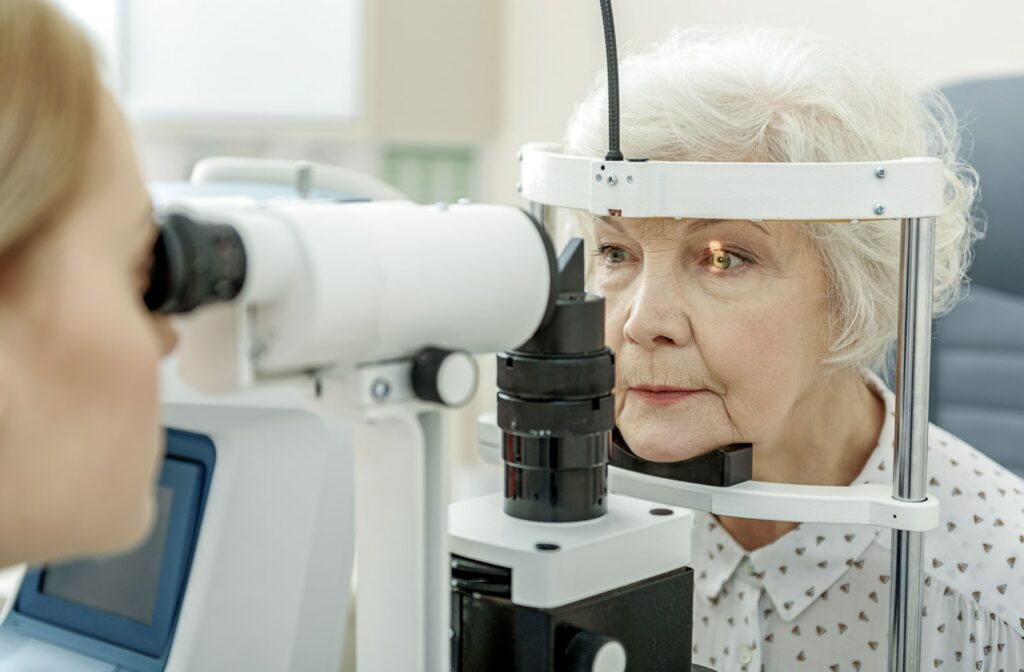Glaucoma is a group of eye diseases that lead to progressive damage to the optic nerve, which carries visual information from the eye to the brain. If left untreated, glaucoma can eventually lead to vision loss and blindness.
Unfortunately, most cases of glaucoma are symptomless. You might only know you have it once it is too late. This is why early detection through eye exams is vital to preserving your vision.
If you experience an acute angle-closure attack, you are more likely to have noticeable symptoms. It is important to note that acute angle-closure glaucoma is a rare incidence—you are more likely to experience open-angle glaucoma with no symptoms.
Below, we’ll discuss common symptoms of acute angle-closure glaucoma.
Vision Loss
Vision loss is one of the most common signs of glaucoma. It usually starts with the loss of peripheral vision and can eventually progress to complete blindness if left untreated. Many people with glaucoma may not notice this gradual decrease in their vision until it becomes severe, which is why regular eye exams are important for early detection.
Pain or Redness in the Eye
Some types of glaucoma, such as acute angle-closure glaucoma, can cause sudden eye pain and redness. This is due to a sudden increase in pressure within the eye, which can be very painful. If you experience sudden eye pain or redness, it is important to seek medical attention immediately.
Haloes Around Lights
Many individuals diagnosed with glaucoma experience the phenomenon of seeing haloes around lights, particularly noticeable during nighttime. This visual occurrence may indicate elevated pressure within the eye, leading to vision distortion.
Blurred Vision
Blurred vision is a prevalent symptom of glaucoma. When blurry vision accompanies other glaucoma symptoms, it may indicate optic nerve damage, hampering clear visual data transmission to the brain. If you notice any abrupt or enduring blurriness in your vision, it’s crucial to seek an appointment with an optometrist.
Tunnel Vision
In some cases of glaucoma, a person’s vision may become limited to only seeing objects directly in front of them. This is known as tunnel vision and can make daily activities difficult. Regular eye exams can help detect early signs of tunnel vision and prevent further damage.
Nausea or Vomiting
In addition to changes in vision, individuals with glaucoma might also encounter symptoms like nausea or vomiting. These symptoms are frequently linked to elevated eye pressure and may be accompanied by other signs such as headaches and eye discomfort.
Types of Glaucoma
There are 2 main types of glaucoma: open-angle and angle-closure.
Open-Angle Glaucoma
Open-angle glaucoma is the most common form, accounting for around 90% of all cases. It occurs when the eye’s drainage system becomes clogged, leading to a gradual increase in pressure within the eye.
Angle-Closure Glaucoma
Angle-closure glaucoma is less common but can be more severe. It occurs when the angle between the iris and cornea becomes too narrow, preventing proper drainage and causing a sudden increase in eye pressure. This type of glaucoma requires immediate medical attention.
Risk Factors for Glaucoma
While glaucoma can affect anyone, there are specific risk factors that can heighten the likelihood of developing this condition. These factors include:
- Age: Individuals over 60 face a greater risk.
- Family History: A genetic predisposition to glaucoma can increase susceptibility.
- Ethnicity: People of African American and Hispanic descent may be at a higher risk compared to other ethnic groups.
- Existing Medical Conditions: Conditions like diabetes and high blood pressure can contribute to the development of glaucoma.
- Prolonged Use of Corticosteroids: Long-term usage of corticosteroids may elevate the risk.
- Eye Trauma or Surgeries: Previous eye injuries or surgeries can be associated with a higher risk.
- Corneal Thickness: Thin corneas have been linked to increased susceptibility.
- Vision Conditions: Nearsightedness is a factor that could influence the development of glaucoma.
- Prior Eye Health Issues: A history of high eye pressure or early indicators of glaucoma may indicate an elevated risk level.

Prevention & Treatment
While there is no known cure for glaucoma, early detection and treatment can help slow down or prevent further vision loss. Regular eye exams are key in detecting glaucoma before any symptoms occur.
Treatment options may include:
- Eye drops to reduce eye pressure
- Oral medications to decrease the production of fluid in the eye
- Laser therapy to improve drainage and reduce pressure
- Surgery, such as trabeculectomy, to create a new opening for fluid drainage
It’s important to follow your doctor’s recommendations and attend regular checkups to monitor your condition. In addition, maintaining a healthy lifestyle, including regular exercise and a nutritious diet, can help prevent or slow down the progression of glaucoma.
Glaucoma Management at Maple Ridge Eye Care
Glaucoma is a serious eye condition that can lead to vision loss if left untreated. It is important to keep up with regular eye exams and knowing your risk factors can also help with early detection and treatment.
At Maple Ridge Eye Care, we are dedicated to providing comprehensive eye exams and helping our patients manage and treat glaucoma. Don’t hesitate to schedule an appointment with us if you have any concerns about your eye health.


